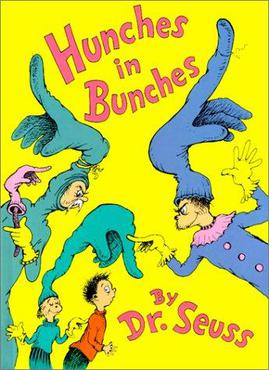Hunches in Bunches facts for kids

Hardcover cover
|
|
| Author | Dr. Seuss |
|---|---|
| Country | United States |
| Language | English |
| Genre | Children's literature |
| Publisher | Random House |
|
Publication date
|
October 12, 1982 |
| Media type | Print (Hardcover) |
| Pages | 48 |
| ISBN | 978-0394855028 |
| Preceded by | Oh Say Can You Say? |
| Followed by | The Butter Battle Book |
Hunches in Bunches is a fun children's book. It was written and illustrated by Theodor Geisel, who is much better known by his pen name, Dr. Seuss. The book was published by Random House on October 12, 1982. It's all about making choices and dealing with lots of different ideas at once!
What is Hunches in Bunches About?
The story follows a young boy who is trying to decide what to do. He faces a big problem: he has too many ideas! These ideas come to life as strange creatures called "hunches."
The Story's Plot
In the book, the boy meets many unusual creatures. Each one is a "hunch" and wears a huge, gloved hat. These hunches pop up and give the boy different suggestions. One hunch might tell him to do one thing, while another hunch tells him to do the exact opposite!
For example, a "Good Hunch" might suggest something helpful. But then a "Bad Hunch" might try to trick him. A "Sour Hunch" could make him feel grumpy. And a "Stuck Hunch" might make him feel like he can't move forward. The boy gets very confused trying to pick the right path. The book shows how hard it can be to choose when you have many different thoughts pulling you in different directions.
Who Was Dr. Seuss?
Dr. Seuss was the pen name for Theodor Seuss Geisel. He was an American children's author, political cartoonist, poet, animator, and filmmaker. He is famous for his many popular children's books. These books often feature rhyming words and imaginative characters.
His Famous Works
Dr. Seuss wrote and illustrated over 60 books. Some of his most well-known works include The Cat in the Hat, Green Eggs and Ham, The Lorax, and How the Grinch Stole Christmas!. His books have sold over 600 million copies worldwide. They have been translated into more than 20 languages. He won many awards for his work, including the Pulitzer Prize.

